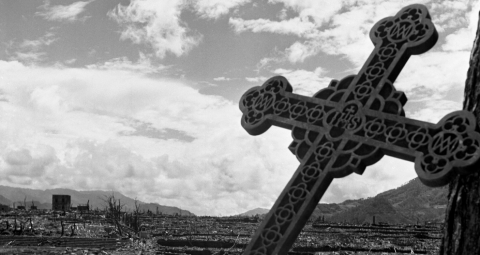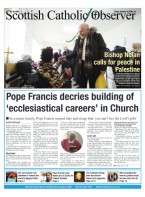September 27 | ![]() 0 COMMENTS
0 COMMENTS ![]() print
print

Keeping the Faith through persecution and nuclear attack
Giuseppe Pezzini on Catholicism in Japan and the incredible story of an A-bomb survivor who put his personal grief aside to strive for peace and reconciliation through a life in Christ.
For Christians, August 15 is the day of the beautiful Feast of the Assumption. For the world, this date marks the anniversary of the formal end of the Second World War in 1945, when Japan surrendered to the Allies. Six days before, an A-bomb was dropped on Nagasaki, an important coastal city in the south-west of Japan, causing the largest single slaughter in human history. For Japanese Christians, August 15 is a date charged with those and even more meanings, which, in mysterious ways, also concern us all.
I will start my story zooming in on the Ground Zero of the Nagasaki bomb, that is the area of Urakami, in the northern outskirts of the city. On a morning of late 1931, 14 years before the bomb, a young man of 23 is walking to a beautiful house near the recently built Catholic Cathedral.
Nagai
His name is Takashi Nagai, a convinced atheist and a proud descendant of a samurai family. He is studying medicine at the nearby university, and needs accommodation: the two-storey house, surrounded by camellias, looks like an ideal place, and Nagai decides to knock at the door asking whether they are interested in taking a lodger.
Nagai had no idea, but that house had been an important site for Japanese Catholicism, the home of the Moriyama family for many generations. Originally from Nagasaki, in the 17th century the Moriyama had receded to Urakami, then a small village, to flee the persecution of Christian. The Moriyama were among the first Japanese to convert after the arrival of the missionaries from the West.
Christianity had come to Japan on another Assumption day (August 15, 1549), when the Jesuit Francis Xavier was allowed to land in the port of Kagoshima, not far from Nagasaki.
Missionaries
Struck by the passion of these missionaries, many converts, from all social classes, joined the Church, which by 1579, the height of missionary activity, counted more than 100,000 members.
Most lived in Nagasaki, which had become a main port for Western trade. Japanese authorities, who were initially interested or at least tolerant, soon became suspicious of this new ‘Western religion.’
Suspicion turned to persecution, and thousands of Christians were martyred, among them St Paul Miki and his companions, crucified in Nagasaki in 1597, and the ‘188 martyrs of Japan,’ beatified by Pope Benedict XVI in 2008, who died between 1603 and 1639.
Persecution
Christian persecution reached its peak in 1639, when a final wave of forced apostasies and brutal executions convinced the shogun authorities that Catholicism had finally been eradicated in Japan. As a magistrate declares in the wonderful novel Silence by the Catholic writer Shūsaku Endō (set in that very year): “Japan is not suited to the teaching of Christianity.
“Christianity simply cannot put down roots here… You have been defeated by this swamp of Japan.”
For Endō’s magistrate, Christianity is a ‘Western’ religion, bounded with the culture, sensitivity, and power of the West, and thus inevitably ‘foreign’: there is no space for it in Japan.
Convictions
In fact, all of his convictions would be proven wrong, in God’s time.
The glorious sacrifice of the Japanese martyrs is just one part of the story of Japanese Catholicism. The protagonists of Endō’s Silence (one of whom is portrayed by Liam Neeson in Martin Scorsese’s film) are not the martyrs, but rather the ‘betrayers,’ the ‘apostates,’—that is the large majority of Christians who did not openly embrace martyrdom, but gave up their Faith (or pretended to do so) by trampling on a desecrating board (the fumie), as required by the authorities.
In his novel, Endō does not justify their apostasy. The betrayal of the Japanese apostates is as sinful as that of Peter in the Gospel, or of the ‘Whisky priest’ in Graham Greene’s The Power and the Glory, which is the main model for Silence. Greene’s novel is also set in an age of persecution, and has as protagonist a sinful, apostate priest, who will yet become an instrument of God’s Providence.
Crypto-Christianity
The Japanese apostasy was also sinful, but, as with the ‘Whisky priest,’ was not ‘the end of the affair’ between God and Japan.
Those ‘unfaithful’ Christians, who had openly given up their Faith, did maintain it in secret, and became Crypto-Christians.
As Endō himself recounts: “The Crypto-Christians… held on to the Faith that had been passed down from their ancestors. But they had to lead a double life. On the one hand, they pretended to be Buddhists; and when they were summoned at the end of each year, they would step on a picture of the Virgin Mary (or fumie) to prove themselves non-Christians. On the other hand, on returning home, they would repent with tears for their unfaithful behaviour.”
The hidden Christians remained open apostates throughout their lives, and yet did not detach themselves from the relationship with God and the tradition of their Faith. With their ‘fidelity within unfaithfulness’ they kept the Christian Faith alive in Japan, for more than two centuries. They had no priests, and no Eucharist, but they appointed leaders overseeing their community life, such as the ‘water man,’ in charge of Baptism, or the ‘keeper of the calendar,’ who preserved the memory of the liturgical feasts.
Headquarters
The Moriyama family, with which Nagai would become associated, were among those leaders, and the house where Nagai sought lodging in 1931 had been for generations the secret headquarters of the Urakami Church.
It was in that very house too, or rather in its cowshed, that the first modern Mass was celebrated in secret in 1865, after Japan was forced by Western powers to re-open its borders to foreigners.
The celebrant of that ‘crib-like’ Mass was the missionary Fr Petitjean, who was astounded at the unexpected discovery that Christianity had not disappeared from Japan, that the seed had not been consumed by the swamp.
The congregation was made of few but staunch Urakami Christians, who had recognised in the French missionary the fulfilment of an ancestral promise, handed over with hope from generation to generation: priests would have come back, and would have been recognised by their celibacy, loyalty to the pope, and devotion to Mary.
Suffering
It was not yet the end of the suffering for Japanese Christianity: less than a year later, the new government decided to intervene to eradicate the newly-sprung weed, before it spread. The Urakami Christians were deported to camps, and brutally forced to apostatise. Many died, but when the persecution ceased, the survivors came back to Urakami. In 1895, with the formal lifting of the ban on Christianity, they began the construction of a cathedral, dedicated to the Virgin Mary herself. The cathedral was completed in 1925, a symbol of a new hope.
It was this cathedral that Takashi Nagai, the convinced atheist mentioned earlier, would walk past as he spotted the Moriyama house.
One of the Urakami survivors who had returned from the camps was the father of Sadakichi Moriyama, who would become Nagai’s landlord, and eventually his father-in-law: in 1934, Nagai married Moriyama’s daughter, Midori, two months after his Baptism into the Catholic Church.
Conversion
In the Moriyama house Nagai found not only love, but also the answer to the existential restlessness that he had since childhood.
His atheism, fostered by his scientific studies, evaporated in the encounter with the beauty of their Christian life. With the Moriyama, Nagai joined the history of Japanese Christianity, the long, uninterrupted chain carried forward through the paradoxical (un)faithfulness of the Crypto-Christians.
He joined that history, and enriched it, eventually becoming the first Japanese Servant of God of the modern age. One can read about his exceptional life in his many writings, and also in Paul Glynn’s brilliant biography, A Song for Nagasaki, reprinted in 2009, with a preface by Shūsaku Endō himself.
Value
Thanks to his charism, Nagai soon became a point of reference for the Christians of Nagasaki, sustained by the love of his wife, Midori. As a radiologist, he was highly respected in the social circles of the city. He also befriended Maximilian Kolbe, who engaged in missionary work in Nagasaki in the late 1930s and was later murdered in Auschwitz and subsequently
canonised.Nagai later ascribed to Kolbe his miraculous survival of one of his many illnesses in the aftermath of the war.
Nagai became Christian, but always remained Japanese: he kept and fostered his patriotism, his love for traditional poetry, and the sensitivity typical of his people. Nagai’s story disproves the claim of Endō’s magistrate, that Christian and Western identity are a necessary symbiosis. More generally, it shows that Christianity transfigures and empowers, rather than wipes off, one’s own tradition, culture, and sensitivity, for the good and enrichment of the whole Church, and indeed of one’s own country and society.
All this was to be clearly shown after the tragedy of August 9, 1945. On that day, Nagai was working, as usual, in his hospital, when the A-bomb fell just 500 metres from the Catholic cathedral, where a congregation was attending Mass in preparation for the Assumption.
Tragedy
All were killed on the spot, together with many thousands more across the city. Others survived the first blow, but died in the following hours, after unspeakable torments. Nagai was close to Ground Zero, but survived because he worked in the radiology department, which was heavily protected. He came out to find a devastation without comparison, a naked hell of torment, and his wife reduced to a bunch of bones.
And yet, even in that very moment Nagai did not yield to despair, and sustained by a line from the Gospel—‘The heavens and the earth will pass away, but my words will never pass away’—he began to tend to the needs of his fellow survivors, both medical and spiritual.
Later he would become a model of reconciliation and rebuilding for all of Japanese society. Nagai was also a prolific writer, and author of a translation of a novel by the Scottish novelist Bruce Marshall. Nagai’s book The Bells of Nagasaki, published 70 years ago in 1949, exactly 400 years after the arrival of Christianity in Japan, became a bestseller and made him known abroad.
Nagai died in 1951, after years of painful but joyful suffering, holding the Rosary Pope Pius XII had given him.
— Giuseppe Pezzini is a lecturer in Latin at the University of St Andrews.










